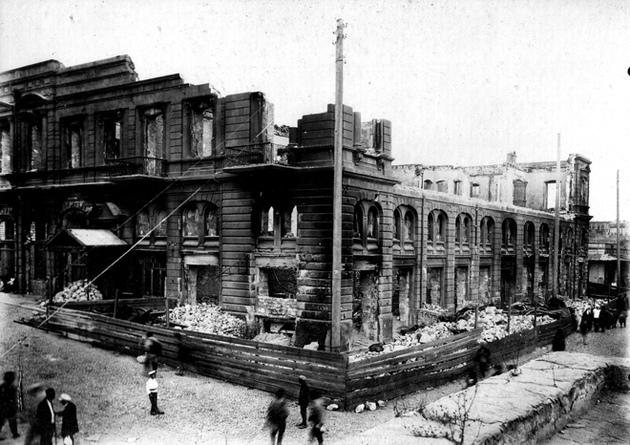The First World War and the February Revolution of 1917 left a deep imprint on Azerbaijan’s fate, as it was a part of the Russian Empire. After the Russian revolutions of the early 20th century, the South Caucasus was engulfed by anarchy and an atmosphere of outrage. The war took place in a difficult economic and socio-political situation. It sharpened ethnic issues on the periphery of the Russian Empire, including the Caucasus.
On March 31st Azerbaijan marks the anniversary of the Day of Genocide of the Azerbaijanis. The Russian population doesn’t know much about it. Soviet science had preferred to avoid talking about the events for 70 years. When the archives were opened, deep studying of the documents enabled us to uncover one of the most tragic pages. It shocked not only the whole region with its cruelty, but also shocked experienced Russian officers and officials. According to some information, 30 thousand peaceful Muslim residents, including women and children, were killed very cruelly from March 30th to April 4th, 1918, on the territory of modern Azerbaijan. Vestnik Kavkaza speaks about the character and consequences of the events on the eve of these tragic days.
On November 2nd, 1917, Soviet rule was declared in Baku; and that’s where it managed to strengthen. The Bolsheviks considered the city to be a stronghold for spreading their power in the South Caucasus. The importance of Baku increased for the Bolsheviks when in February 1918 the Transcaucasian government prevented an attempt by the Bolsheviks to capture power in Tiflis. Major forces of the Bolsheviks had to leave Georgia and focused on Baku.
The real power was concentrated in hands of the Baku Council; Stepan Shaumyan was elected its chairman. He was appointed by Lenin as the extraordinary commissar for Caucasus affairs on December 16th, 1917. However, the opposition party Musavat was an obstacle to the absolute power of the Bolsheviks. Musavat was supported by the Azerbaijani population. According to Shaumyan, “by the second year of the revolution, Musavat was the strongest political party in the South Caucasus.” The Bolsheviks and Dashnaktsutyun were especially concerned about the successes of Musavat in early 1918. After the October revolution of 1917, the party shifted to intensive activities. By March 1918 Musavat had turned into the leading political force in Azerbaijani society, managing to unite “the majority of Muslim population of Azerbaijan.”
Power belonged to Musavat in a significant part of the Baku and Elisavetpolskaya (Ganja) Province by that time.
Shaumyan tried to cut Musavat from the political struggle and discredit it by any means under such conditions. From the early days of their rule the Bolsheviks were ready to cooperate with any political forces to maintain their power. That’s how the military alliance appeared between the Bolsheviks and the Armenian National Council, which controlled Armenian armed groups.
In summer 1917 the Provisional Government, which had tried to stop the process of corruption on the front, decided to establish ethnic military groups. Numerous ethnic committees began to appear; troops of the Caucasus front were nationalized, while the front suffered dissolution. In June the Armenians were granted the right to form a brigade. When the Provisional Government collapsed on December 13th 1917, the supreme commander of the Caucasus front ordered the formation of the Armenian Corps. It included Armenian soldiers who were gathered from all Russian fronts.
According to Baikov, a member of the Party of Cadets, due to the absence of railway communication between Baku and Tiflis for two months, in Baku “about 8,000 Armenian soldiers gathered, who had returned from European fronts of the war and were armed.” Plus, there were several thousand well-armed militants of Dashnaktsutyun. It is clear that at that moment the balance of military forces in Baku was not in favor of Musavat.

There were thousands of well-armed militants of Armenian Dashnaktsutyun. Shaumyan was aware of the nationalistic views of the Dashnaks. The Bolsheviks were preparing for a crucial fight. Ahead of the events in March, the Baku Council received significant military and financial aid from Petrograd. The Bolsheviks worried that the political influence of Musavat, which was supported by real military forces (ethnic units), would make it invincible. Such a development of the situation would make Musavat the leading player on the political stage of Azerbaijan. The Bolsheviks decided to make a pre-emptive strike at Musavat and achieve complete destruction of the national movement in Azerbaijan.
However, the scale of the tragedy in March 1918 was predetermined not only by the objective factors mentioned, but also by the fact that Shaumyan was the head of the Baku Council. In comparison with other Bolshevik leaders, he was the strictest opponent of peoples’ right to self-determination, rejecting even a simple declaration of the principle. Stressing the error of such a position, Lenin addressed Shaumyan in 1914: “Isn’t it a shame for a Russian Marxist to take the position of the Armenian hen house? …because of your ‘Armenian’ blindness, you become a supporter of Purishkevich and other nationalists.”
At the same time, in spring 1918 the Bolsheviks needed real military support in the struggle against Musavat, and only Dashnaktsutyun could provide such support at the time. Shaumyan’s desire to destroy the national forces of Azerbaijan by any means made him cooperate with ultra-nationalistic Armenian groups headed by Dashnaktsutyun.
By deciding to establish a military political union with Dashnaktsutyun in March 1918, the Bolshevik leaders relied on the fact that the Dashnaks were well-armed and were militarily experienced, due to their participation in the First World War. The whole military experience of the Dashnak groups was used against the peaceful Azerbaijani population of Baku Province during the events of March.
The Bolsheviks attracted the Dashnaks to their side by the Decree on Turkish Armenia of December 29th 1917, which was signed by Lenin and Stalin. The Decree required the establishment of an Armenian autonomy on the Turkish territories occupied by the Russian army. The leaders of the Bolsheviks made Shaumyan responsible for fulfillment of the Decree. He was ordered to provide Armenian organizations with broad support “for fulfillment of the national idea for which the suppressed Armenian people had been waiting for centuries.”
The fact that the Bolsheviks needed only a motive for starting massacres is confirmed by Shaumyan’s memories: “We used a motive. It was the first attempt to attack our cavalry unit. We began an attack along the whole front… we already had 6 thousand armed men. Dashnaktsutyun had 3-4 ethnic units which were controlled by us. Their participation made the civil war look like an ethnic massacre, but it couldn’t be avoided. We did it on purpose.”
The Bolsheviks and Dashnaktsutyun forgot about their political confrontations and formed a military political union against Musavat in Baku. Moreover, units of the Red Army of the Baku Council included mainly Armenians, who were commanded by Dashnak officers at the front. During this period the head of the Red Army in Baku was Colonel Avetisyan, a member of Dashnaktsutyun. Another member of the party Amazasl, who was sadly known for his outrages against Azerbaijanis, commanded the 3rd brigade of the Red Army. So it’s no surprise that not only Armenian groups, but also the Red Army actively participated in massacres against peaceful Azerbaijanis.
All districts of Baku, starting from the center and ending with the suburbs, were attacked by Bolshevik-Dashnak units. The struggle for power turned into a mass massacre of the Azerbaijanis. A member of the Bolshevik Party, Blyumin, had to admit: “The Dashnak units did their cruel business; instead of a civil war, we got an ethnic war; they murdered up to 20,000 poor Muslims.”
Another member of the Bolshevik Party, Baranov, also confirmed the fact of massacres of Muslims in Baku by the Dashnaks: The Red Army and the party’s groups assaulted the gates of the fortress from Nikolai Street, near the Metropol Hotel. Dashnaktsutyun was operating in the same district, and they murdered all the Muslims instead of suppressing Musavat’s riot.”
More than 12 thousand peaceful Azerbaijanis were victims of the events in Baku and its suburbs. It should be noted that a large number of them were not killed on the streets, but in their own houses. Groups of marauders (5-10 people) followed armed units of the Bolsheviks and Dashnaks. The marauders were mainly Armenians. And while the armed forces of the Baku Council were establishing control over certain districts of the city, the marauders provided mopping-up operations. This meant robbing and murdering peaceful Azerbaijanis. The groups had one and the same scenario of acting. First of all, they shot at the houses of Azerbaijanis to make people ran away from them; then they burst into the houses and robbed them.
Massacres of Azerbaijanis started on March 30th and continued for a week. Terrible outrages against the Azerbaijani population of Baku took place in the city. According to witnesses, blood was actually running down the streets.
Before killing the Azerbaijanis, Dashnak militants tortured and tormented them. For example, in the well-known ‘Fantasy’ bathhouse, Azerbaijanis were thrown alive into boiling water. When their bodies were found, their bones were burned, while the soft parts of their bodies fell off.
In the Mailovsky Theater hundreds of peaceful Azerbaijanis were imprisoned. Dashnak militants herded crowds of people to the theater. They often shot people dead nearby and disfigured them. Such inhumane actions by the Dashnaks shocked some Russian soldiers. One of them said about the events of March 1918 in Baku: “They kill peaceful Muslims, slaughter them and domestic animals needlessly; infectious diseases are spread from the corpses. We cannot stop this. These are not people, but beasts who long for blood.”
The massacres continued even when Musavat accepted all the requirements of the ultimatum by the Bolsheviks on March 31st. Only on April 2nd did the leadership of the Baku Council officially agreed on making peace with the Azerbaijanis. However, murders and robbing continued in Azerbaijani districts till April 5th.
According to witnesses, after the end of the bloody massacre hundreds of disfigured corpses of Azerbaijanis lay on the streets of Baku. There were bodies of women and children with ripped open stomachs and cut hands and legs. An awful stench had covered the city for a long time after the March tragedy.
Even the Menshevik newspaper ‘Our Voice’, which initially supported the activities of the Baku Council, stated that the developments in the city were “ethnic massacres.” The newspaper was shut down at once, due to “biased articles and inappropriate assessment of the developments.”
Shaumyan tried to blame the Armenian side for the mass murders of Azerbaijanis in Baku. He admitted that “a lot of poor and homeless Muslims suffered” as a result of the March events. He explained this was due to the fact that the Bolsheviks “had to use the support of the Armenian regiment, and they couldn’t reject their services.” At the same time, he shamelessly stressed that “the victory is so great that it doesn’t worsen the reality.”

Meanwhile, the Bolsheviks and Dashnaks organized massacres of Azerbaijanis not only in Baku, but also in other regions of Baku Province. Along with the Baku events, Azerbaijani massacres started on March 30th in the Shemakhinsky Region of Baku Province. Just as in Baku, the Bolsheviks and Dashnaks were ready for the actions beforehand. Since January 1918 a lot of arms and bullets had been brought to villages of the Shemakhinsky Region.
Shaumyan tried to create the impression of a big counter-revolutionary threat to the power of the Baku Council and reported to Moscow about bloody fights in Shamakha and the withdrawal of the defeated forces of the Baku Council, which were told to leave the region together with the Armenian population.
On April 13th Shaumyan reported to the Council of People’s Commissars of the RSFSR that he had sent “a new unit with artillery and machine guns there.” The unit was headed by Stepan Lalayev, who destroyed the ancient city and murdered the majority of its population. A witness of the events, Bocharov, noted: “In one night the city was destroyed. The population was massacred. A commission headed by Dzhaparidze went to the city. The commandant of Shemakha, a member of Dashnaktsutyun named Pakhlatsin, was dismissed, and his unit was dismissed as well, as it did nothing during the massacre. Stepan Lalayev was also sent away from the city.”
Soon after the assault Armenian troops entered the city. By the evening of March 30, the Azerbaijani resistance in Shamakhi was finally broken, the city was completely destroyed, and set on fire.By order of the commander of the Armenian forces, Stepan Lalaev, every single mosque in the city, where according to Muslim traditions, women, children and the elderly were hiding, were surrounded and set on fire. People hiding in the mosques died in the fires, and those who tried to run out into the street were killed by the soldiers.On the personal orders of Stepan Lalaev, young Azerbaijani women were brought to his own house in Shamakhi, where soldiers undressed them, woman were made to drink, forced to dance to the sounds of zurna, then raped, after which some were killed on the spot, while others were thrown from a high balcony onto the street.The scale of destruction in Shamakhi during the March events is evidenced by the fact that of the 5000 houses in the town only the Realschule building survived.Trying to escape the pogroms, the urban population of Shamakhi took refuge in nearby villages. However, riots spread to these villages too. In total, 58 Azerbaijani villages were destroyed in the Shamakhi District during the March events. The number of civilians killed by Armenians in the Shamakhi District reached 7000 people, including 1653 women and 965 children.After Baku and Shamakhy, a tragic fate befell the Azerbaijani population of the Guba District of Baku Province. Guba is the third largest city, where the Bolsheviks headed by Shaumyan decided to extend their authority. Armenians were less numerous and active in the Guba District, with its multi-ethnic population. Here Jews, Russian sectarians, Tats and Lezghins lived, along with the numerically dominant Azerbaijanis. On the initiative of Shaumyan, the 2000th detachment under the command of the Dashnaks' Hamazasp Srvandztyan was sent to the district. Under the personal direction of Shaumyan, the selection of the soldiers in this unit was carried out by a military commissar of the Baku Soviet, Korganov, so it consisted exclusively of Armenians who belonged to the Armenian Revolutionary Federation party (Dashnaktsutyun).On May 1, three thousand Armenians under the command of Dashnak Hamazasp Srvandztyan (well-known for his hatred of Muslims) entered Guba. It was also part of the Red Army.Ilyantsev, who served in the Red Guard of the Jewish settlement of the Guba District, remembers the arrival of Hamazasp's squad in Guba: "A few days later we heard that Hamazasp's squad of 1500 people arrived. During the journey he burned the villages. It turned out that Hamazasp came disguised as a Bolshevik, but he and his squad created an ethnic massacre, burning villages and towns, robbing people and then leaving."
Soon after the assault Armenian troops entered the city. By the evening of March 30, the Azerbaijani resistance in Shamakhi was finally broken, the city was completely destroyed, and set on fire.
By order of the commander of the Armenian forces, Stepan Lalaev, every single mosque in the city, where according to Muslim traditions, women, children and the elderly were hiding, were surrounded and set on fire. People hiding in the mosques died in the fires, and those who tried to run out into the street were killed by the soldiers.
On the personal orders of Stepan Lalaev, young Azerbaijani women were brought to his own house in Shamakhi, where soldiers undressed them, woman were made to drink, forced to dance to the sounds of zurna, then raped, after which some were killed on the spot, while others were thrown from a high balcony onto the street.
The scale of destruction in Shamakhi during the March events is evidenced by the fact that of the 5000 houses in the town only the Realschule building survived.
Trying to escape the pogroms, the urban population of Shamakhi took refuge in nearby villages. However, riots spread to these villages too. In total, 58 Azerbaijani villages were destroyed in the Shamakhi District during the March events. The number of civilians killed by Armenians in the Shamakhi District reached 7000 people, including 1653 women and 965 children.
After Baku and Shamakhy, a tragic fate befell the Azerbaijani population of the Guba District of Baku Province. Guba is the third largest city, where the Bolsheviks headed by Shaumyan decided to extend their authority. Armenians were less numerous and active in the Guba District, with its multi-ethnic population. Here Jews, Russian sectarians, Tats and Lezghins lived, along with the numerically dominant Azerbaijanis. On the initiative of Shaumyan, the 2000th detachment under the command of the Dashnaks' Hamazasp Srvandztyan was sent to the district. Under the personal direction of Shaumyan, the selection of the soldiers in this unit was carried out by a military commissar of the Baku Soviet, Korganov, so it consisted exclusively of Armenians who belonged to the Armenian Revolutionary Federation party (Dashnaktsutyun).
On May 1, three thousand Armenians under the command of Dashnak Hamazasp Srvandztyan (well-known for his hatred of Muslims) entered Guba. It was also part of the Red Army.
Ilyantsev, who served in the Red Guard of the Jewish settlement of the Guba District, remembers the arrival of Hamazasp's squad in Guba: "A few days later we heard that Hamazasp's squad of 1500 people arrived. During the journey he burned the villages. It turned out that Hamazasp came disguised as a Bolshevik, but he and his squad created an ethnic massacre, burning villages and towns, robbing people and then leaving."
Another witness of the events, Mir Musa, a member of the red squad in Guba, remembered, " The Dashnak Hamazasp began cracking down on the Turkic population. Mass terror, robbery and murders began."
There were cases when people met Hamazasp's squad with white flags as an expression of humility. However, Hamazasp's soldiers did not even talk with them, they shot them and destroyed the villages. For example, this happened at the Divichi Bazar and Kyzyl-Burun villages, the inhabitants of which sent 15 venerable old man with bread and salt to meet Hamazasp. The soldiers shot them all.
On the morning of May 1 Hamazasp's squad surrounded the city of Guba, located 170 kilometers north-east of Baku, and began firing at it with cannons, machine guns and rifles, although it was not necessary, as the residents of the city did not intend to provide any resistance. Nevertheless, taking the city was accompanied by a massacre of the Muslim population. Soldiers shot men, women and children, broke into houses and massacred entire families, not sparing even infants, who were killed directly on their mother's breasts.
Hamazasp's soldiers ordered old men to deliver Muslim women to them, and if they failed to do so they were killed on the spot. A resident of Guba, Ali Pasha Karbalai Muharram oglu, and his son were killed for failing to comply with such an order.
The establishment of Soviet power in the Guba District by Hamazasp's squad ended with the deaths of about 2000 Azerbaijani civilians. Soldiers of the Hamazasp detachment, as well as their associates in other regions of the country, were also engaged in looting and pillaging, in addition to murder.
During the spring of 1918, the Bolshevik-Dashnak troops in Baku, Shamakhi, Guba, Lankaran, Zangezur, Karabakh and other regions of Azerbaijan killed about 30,000 Azerbaijani civilians. Tens of thousands of Azerbaijanis were forced to leave their homes and become refugees in their own country.
A member of the Extraordinary Commission of Inquiry, the experienced lawyer A.E.Kluge, in his report "On the case of violence against the Muslim population of Baku city" confirms, on the basis of numerous witnesses and the examination of places, that in late March and early April 1918 alone, Armenian armed groups killed more than 11,000 Azerbaijanis, most of whom belonged to the underprivileged section of the population.
However, despite the fact that as a result of the March events the Bolshevik-Dashnak leadership of the Baku Soviet managed to become the absolute master of the city, the victory was Pyrrhic. The March events marked the beginning of the end of Soviet power in Baku, and two months later the Azerbaijan Democratic Republic was formed, which, however, existed for only 22 months.
In the spring of 1918 the Soviet government in Azerbaijan was established on the blood of thousands of Azerbaijani civilians. But the worst thing was that the atrocities against Azerbaijani civilians were repeated 70 years later in Karabakh. The script and the character of the violence in the small village of Khojaly in February 1992 were very similar to what happened in 1918 in Azerbaijani cities.






